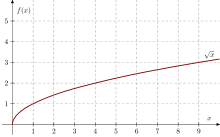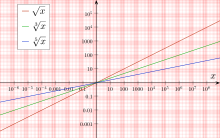Nth root
In mathematics, root extraction or root extraction is the determination of the unknown 
Here, 



![{\displaystyle x:={\sqrt[{n}]{a}}}](https://www.alegsaonline.com/image/640515457bfa1a33bcb3ceebbedfcba5c8728d58.svg)
Definition, Speech and Spelling
Let 

exactly one non-negative real solution. This is called the 

Here one designates
as root, radical or radix,
as the root character,
as the root exponent,
as a radicand.
In the special case 
![{\sqrt[{1\,}]{a}}=a](https://www.alegsaonline.com/image/395d1ccce97a71bc1bdd70dac58d27397e455865.svg)
square and cube root
Usually the second root is called the square root or just the root and the root exponent is omitted:
The root with the root exponent 3 (third root) is also called the cube root.
Example:
(Say: The third root of 8 is 2 or The cube root of 8 is 2)
Mathematical basics
The following description of radixing as a right-unique root function refers to the ordered body 
Connection with powers
Rooting with the root exponent 



The root exponent 

Therefore, radixing with the root exponent n can also be interpreted as exponentiating with the exponent 1/n:
Uniqueness of roots from positive numbers
Although the problem mentioned at the beginning has two solutions with different signs for even root exponents and positive radicands, the notation with the root sign ![{\sqrt[{}]{}}](https://www.alegsaonline.com/image/2728884d0378cc133178d711fe6fef12aad386f6.svg)



![{\sqrt[{2}]{4}}](https://www.alegsaonline.com/image/3b6caa44c96c5446c370b7e361bc7995a5f88e6b.svg)
Roots from negative numbers
The treatment of roots from negative numbers is not uniform. It is valid for example
and 

Regarding odd roots from negative numbers, the following positions are taken:
- Roots of negative numbers are generally undefined. For example,
is thus undefined. The solution to the equation
is written as
.
- Roots of negative numbers are defined when the root exponent is an odd number (3, 5, 7, ...). For odd numbers
holds in general
![{\sqrt[{2n+1}]{-a}}=-{\sqrt[{2n+1}]{a}}](https://www.alegsaonline.com/image/853a51339773f257d26c74c4ab194d3d14afe0c3.svg)
This determination is inconsistent with some properties of roots that apply to positive radicands. For example
Also, this definition does not work with the equation ![{\displaystyle {\sqrt[{k}]{a}}=a^{\frac {1}{k}}=\exp \left({\tfrac {1}{k}}\ln(a)\right)}](https://www.alegsaonline.com/image/216d5c54f7f67bb0ebca1cfcf89fdcba53d0e91c.svg)

Roots to even exponents of negative numbers cannot be real numbers, because even powers of real numbers are never negative. There is no real number 

![x={\sqrt[{2}]{-1}}](https://www.alegsaonline.com/image/e1812089401a487eead8d3598b99a8faef4f797e.svg)
Irrational roots from integers
If 

![{\sqrt[ {k}]{n}}](https://www.alegsaonline.com/image/81bef6d66e5171e992486e360c88405f74418934.svg)
If 
![{\displaystyle {\sqrt[{k}]{n}}=n}](https://www.alegsaonline.com/image/3e0bd2f81f0e524e982629ec402cd925677ee6f0.svg)






![{\displaystyle {\sqrt[{k}]{n}}=p_{1}^{e_{1}/k}\dotsm p_{r}^{e_{r}/k}}](https://www.alegsaonline.com/image/791988f073b0073488922c56bfc7936279cbce00.svg)
Now it remains to show: If there is at least one 



![{\sqrt[ {k}]{n}}](https://www.alegsaonline.com/image/81bef6d66e5171e992486e360c88405f74418934.svg)

Suppose ![{\sqrt[ {k}]{n}}](https://www.alegsaonline.com/image/81bef6d66e5171e992486e360c88405f74418934.svg)


![{\displaystyle {\sqrt[{k}]{n}}={\frac {a}{b}}}](https://www.alegsaonline.com/image/b4268bd657206acd28fbb5f63a5750b6ee29cf4f.svg)
By exponentiating the equation you get
and from this follows

The prime factor 










![{\sqrt[ {k}]{n}}](https://www.alegsaonline.com/image/81bef6d66e5171e992486e360c88405f74418934.svg)
The root laws
The calculation rules for roots follow from those for powers.
For positive numbers 


- Product rule:
- Quotient rule:
- "Nesting rule" or iteration rule:
- Definition for fractional exponents:
- Definition for negative exponents:
- With the same radicand,
For negative numbers 



Limit values
The following limits apply:
for
This follows from the inequality ![n<\left(1+{\sqrt[{2}]{\tfrac {2}{n}}}\right)^{n}](https://www.alegsaonline.com/image/899811ee94f8bbe73cd9e6eec5b97aa6bb8344ca.svg)
, where
an arbitrary but fixed natural number.
,
as can be seen from the exponential representation of .
Root functions
Shape functions
![f\colon \mathbb {R} _{0}^{+}\to \mathbb {R} _{0}^{+},x\mapsto {\sqrt[{n}]{x}}](https://www.alegsaonline.com/image/ac3e293c7e03dcc3cc38c88700e4137f03ca57e1.svg)
are called root functions. They are power functions, it holds ![{\sqrt[{n}]{x^{m}}}=x^{\frac {m}{n}}](https://www.alegsaonline.com/image/3d91b3c9d16a74ea1b7bc7f51573f8204a6f7e76.svg)
Questions and Answers
Q: What is an n-th root?
A: An n-th root of a number r is a number which, if multiplied by itself n times, produces the number r.
Q: How is an n-th root written?
A: An n-th root of a number r is written as r^(1/n).
Q: What are some examples of roots?
A: If the index (n) is 2, then the radical expression is a square root. If it is 3, it is a cube root. Other values of n are referred to using ordinal numbers such as fourth root and tenth root.
Q: What does the product property of a radical expression state?
A: The product property of a radical expression states that sqrt(ab) = sqrt(a) x sqrt(b).
Q: What does the quotient property of a radical expression state?
A: The quotient property of a radical expression states that sqrt(a/b) = (sqrt(a))/(sqrt(b)), where b != 0.
Q: What other terms can be used to refer to an n-th root?
A: An n-th root can also be referred to as a radical or radical expression.
Search within the encyclopedia





![{\displaystyle x={\sqrt[{n\,}]{a}}}](https://www.alegsaonline.com/image/e5b247ec7cb0b4dc530599781caf66474e9b4b37.svg)
![{\sqrt {a}}={\sqrt[{2}]{a}}](https://www.alegsaonline.com/image/703568c12856d81ba503e45df79ef89b2eac426a.svg)
![{\sqrt[{3}]{8}}=2](https://www.alegsaonline.com/image/1f378331b0d609846c021c1a0bbff0a4fc1755c3.svg)
![\left({\sqrt[{n}]{a}}\right)^{n}=a](https://www.alegsaonline.com/image/64cb04ba3b309b574960aaf2b7141e4faae06216.svg)

![{\sqrt[{n}]{a}}=a^{\frac {1}{n}}](https://www.alegsaonline.com/image/2211e22214f87e6a2303d3d4c2465a3229984bde.svg)
![{\sqrt[{2n}]{x^{2n}}}=|x|\,.](https://www.alegsaonline.com/image/cd28bc64b4878d053459208c9b779b449d1f450f.svg)

![-2={\sqrt[{3}]{-8}}\neq {\sqrt[{6}]{(-8)^{2}}}={\sqrt[{6}]{64}}=+2.](https://www.alegsaonline.com/image/ef94c9d7cc0583ab90a2ccd29f9d0fbcd44e8a29.svg)

![{\sqrt[{n}]{a}}\cdot {\sqrt[{n}]{b}}={\sqrt[{n}]{a\cdot b}}](https://www.alegsaonline.com/image/eb1cdc44e892d181f2e52332608a940e0d9f9a6b.svg)
![{\frac {\sqrt[{n}]{a}}{\sqrt[{n}]{b}}}={\sqrt[{n}]{\frac {a}{b}}}](https://www.alegsaonline.com/image/4a051c5fb0f6593e2d1e6a84d3ab614ffbab3eb2.svg)
![{\sqrt[ {m}]{{\sqrt[ {n}]{a}}}}={\sqrt[ {m\cdot n}]{a}}](https://www.alegsaonline.com/image/e1ef8ace9d360ced62f31f7d66eca161594dfc83.svg)
![{\displaystyle a^{\frac {k}{n}}={\sqrt[{n}]{a^{k}}}=\left({\sqrt[{n}]{a}}\right)^{k}}](https://www.alegsaonline.com/image/454a14abc9cf67996458174bdece47ad99abf16e.svg)

![{\displaystyle {\sqrt[{m}]{a}}\cdot {\sqrt[{n}]{a}}=a^{{\frac {1}{m}}+{\frac {1}{n}}}={\sqrt[{mn}]{a^{m+n}}}}](https://www.alegsaonline.com/image/59645055e4042edf582c276a2456fe9af63bb6a3.svg)

![\lim _{n\rightarrow \infty }{\sqrt[{n}]{n}}=1](https://www.alegsaonline.com/image/5d1dd63871920301086721f8d139653b5c276c71.svg)
![{\sqrt[{n}]{n}}](https://www.alegsaonline.com/image/61402e0a053d2f40af8ee61ff361d232500e92d6.svg)
![x\mapsto {\sqrt[{n}]{x^{m}}}](https://www.alegsaonline.com/image/1c02b2d66b50710298e8786139c80d90b584e54a.svg)